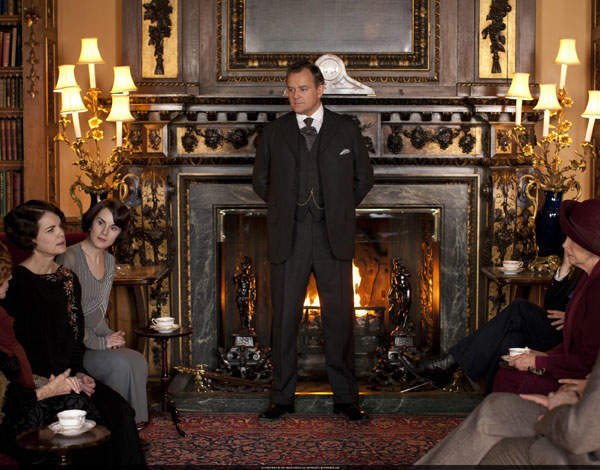

UPSTAIRS DOWNFALL
Britain’s stately estates have proved, over the centuries, as much millstones as treasures. They have been granted by kings, bought by industry, enjoyed by generations of a family — but sometimes families run into a dead end, or deep pockets turn up shallow, and the expenses of running the house, the staff, the farm and all else compel a sale.
In September, Kinpurnie Castle in Angus was put on sale for £29 million by Nigel Cayzer a year after the death of his uncle and the estate’s former owner, Sir James Cayzer. More recently, it was announced that the village of Bantham in Devon is to be sold as part of the Evans Estate (£35 million in total), another end-of-the-line disposal.
The truth is not — solely — that heirs are pawning the family silver (though with no chance of recovering it), but that the purpose of these estates has changed — or vanished entirely. The old ways no longer work. Anyone trying to keep their estate together is going to have to think of them now as modern businesses, which is easier said than done.
Read more on landed estates from Spear’s
The days of landed estates being buzzing centres of family life, run by an army of staff and frequented by endless relatives (whose version of a weekend visit was often a whole month), have long gone. ‘If one goes back to Downton days, the house was a living, breathing thing, the centre of a community, and there was a focus on it being the home of the family, as well as being a provider of employment,’ says Jeremy Curtis, partner at law firm Pemberton Greenish.
For many people, these large houses are antique overheads that are too expensive to live in — a situation that will only worsen as fuel prices rocket, rendering the cost of running such a place out of reach for all but the most liquid of landowners. Owning a grand house on an estate is, therefore, perhaps not the glamorous affair one might imagine.
‘In my experience, the notion that traditional family estates are a goldmine is entirely misplaced,’ says James Townshend, chief executive of farming company Velcourt Group. His wife Charlotte inherited both the Galway Estate and the Ilchester Estate following the deaths of her two brothers. ‘The reality is that most estates have a high demand for capital expenditure not only to maintain the status quo in terms of enterprise generation but also to keep up with substantial repair, not to mention tax liabilities.’
Curtis agrees that a glittering inheritance might in fact be fool’s gold. ‘Some people say, “I’ve inherited a millstone, a bottomless money pit!”‘ he says. ‘Anyone who maintains their own house will know what it costs — multiply that by the size of the house and you’ll know what’s involved.’
Dried streams
Another issue is that estates used to provide an income for the whole family. ‘Traditionally one would get the estate and then provide for the other siblings out of the non-estate-related assets,’ says Curtis. ‘In the past that was easier to do but now a lot of estates don’t have enough revenue from their land to maintain the house and all that goes on around it, meaning everything, including much of the non-estate-related assets, has to be poured back into the house itself.’
Clearly, generating higher revenue is of benefit to the estate, the primary owner and their family and employees. But how does one go about doing this today in a commercial fashion? A good example of really maximising a private family estate’s assets is the case of Cornbury Park, the Cotswolds home of Lord and Lady Rotherwick.
The estate essentially operates as a multifaceted business. Not one bit of it is left unutilised: the house and its grounds are available to hire for film and photo-shoots as well as weddings and parties; the land is used for arable farming, deer stalking, field sports parties, fishing and other events; and the estate property is rented out both on a residential basis and as office spaces. It certainly sounds like Lord and Lady Rotherwick have their work cut out for them.
HRH The Prince of Wales is known to actively invest in and commercialise his Duchy of Cornwall estate, whose property portfolio includes the Oval cricket ground in south London; he was even recently described as having a ‘hard-nosed business ethos’. While criticising the estate’s tax breaks, Margaret Hodge of the Commons Public Accounts Committee did point out that ‘what started off 700 years ago as a medieval estate today demonstrates all the features of a modern big corporation’. It’s not clear whether this was meant as a compliment — but it should be taken as one.
In the last financial year the Duchy generated a total of £28.8 million, out of which the Prince received an income of £19 million. (How much of this was from oat biscuits is not known.) This is up 4 per cent on the previous year, according to its annual report. Business is certainly booming for the enterprising prince.
A problem shared
When there are multiple owners and beneficiaries, all parties need to have similar expectations and ambitions regarding the enterprise, says Curtis. ‘Jointly owned estates can be problematic as the owners’ outlooks are not always aligned, which can lead to the splitting of estates.’ But, he adds, it can work if the parties concerned work well together and form a joint enterprise, just like any other family business. ‘After all, there are lots of farming families who work together.’
The best way to manage family estates with joint heirs or multiple beneficiaries is to create a family constitution, according to Clive Beer, a director at Savills specialising in contentious practice and strategic property advice. The constitution is a confidential family document that outlines the family’s vision and agreements on the ownership and management of their family business.
Ultimately, it provides greater transparency. ‘This then reduces contention as beneficiaries don’t get any surprises, which is a key trigger for grievances,’ explains Beer. ‘With wealth comes responsibility. That’s how the family constitution works, as people are then obliged to become actively involved in running the family estate that they have a stake in, rather than taking a back seat.’ It also protects the asset from falling prey to outside sources, in a similar way to a pre-nuptial agreement.
This system has proved particularly popular among intelligent newly wealthy families, says Beer. So perhaps Britain’s old moneyed estates should learn a trick from their more recently endowed counterparts — if they want to keep heart and hearth together.






